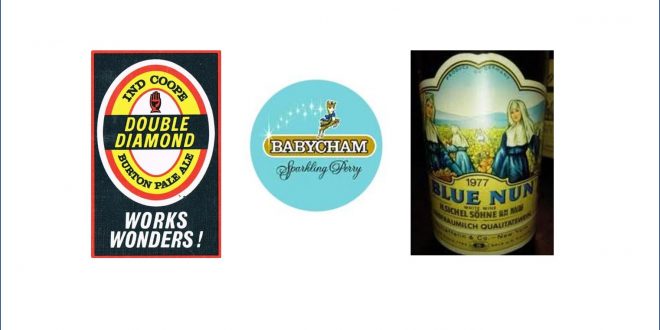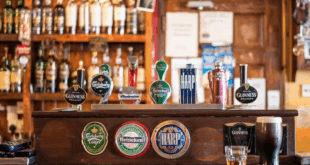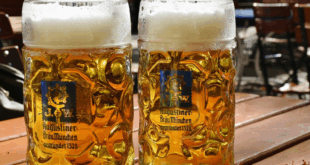Enter a bar today and we are spoilt for choice. Supermarkets have aisles of wines to choose from, not so long ago, it wasn’t the case.
In the 1970s, most pubs were owned by breweries limiting not only their beer choice, but that of other drinks as well. Supermarkets were much smaller than today, stocking only leading national brands, and if you were lucky, a few different wines. TV advertising maintained the leading brands awareness.
Here are three forgotten brands, that were once ubiquitous.
Double Diamond
“A Double Diamond works wonders” was sung on commercials and plastered on bill boards, many pubs had distinctive illuminated orange signs. Everyone knew about Double Diamond. It was the era of keg beers. Unlike their real ale predecessors, they had long shelf lives and didn’t require cellar skills at the pub. They were probably cheaper to brew and distribute but could be sold at a premium, the big breweries and their shareholders loved them. The brewer was Allied Breweries, owners of Tetleys, Ind Coope and Ansells. It was one of the first nationally available keg beer brands.
It’s fall from grace was dramatic. On one side, the rise of CAMRA and the recovery of real ale resulted in a rejection by swathes of beer drinkers of heavily promoted bland beers such as DD. But, the brewers themselves ultimately sealed its fate. Lager style beers could be sold at even higher prices, increasing profits further, so attracted the marketing spend. Once the promotion stopped, brands like Double Diamond soon declined.
Apparently, Double Diamond is the favourite tipple of the Duke of Edinburgh, and is reputedly kept supplied from a brewery somewhere. To appease CAMRA, a real version, Burton Ale was launched, this outlived it’s keg cousin.
Babysham
A early marketing created super brand, Babycham was launched in the 1950’s. Through clever marketing, a Perry (cider made with pears) became a premium priced drink. During the 1960s and 1970’s pubs and bars were becoming more popular with women, and Babycham was a popular drink choice (there wasn’t much choice). Few bars and pubs at this time served wine.
This was an era when advertisers could get away with strategies not possible today, Babycham was promoted as Champagne Perry, much to the annoyance of the French. The small bottles had foil covered caps, to add class! It was correctly served in Babycham branded Champagne glasses. It was the first widely advertised alcoholic drink on TV. The Christmas adverts for Babycham were memorable, look on You Tube for them.
It is still available and has had several relaunches over the years, now though, volumes are tiny compared to what they were.
Blue Nun
Up until the 1960’s, Britain was not a wine drinking nation. Although the better off had drunk it for centuries, for most of us, it was something for special occasions if at all. Few pubs offered it by the bottle, even rarer by the glass. Partly due to the growth of foreign holidays more people were getting the taste for it. A problem though was what to buy. Most wine dealers were not seen as welcoming places for the learner wine drinker and there were no well known brands to fall back on. “I’ll have a dry (or sweet) white wine” was a common drink request in a pub. It didn’t help that French winemakers, then as now, kept the wine inside the bottle a secret.
Blue Nun filled the void. In the 1950’s, German producer H. Sichel Söhne turned to marketing for help. They chose a simple name, foregoing German tradition for long complex ones. As for the wine, it was inoffensive, fairly sweet and low on alcohol. Critically described as an ideal wine for non wine drinkers. Widely stocked by local shops, the name was easy to remember and it was easy to buy. By using the productive Müller-Thurgau grape, prices were competitive. Supported by advertising, the strategy was successful. Blue Nun achieved huge success in both the UK and USA. In traditional wine drinking nations, it was virtually unknown, even in Germany. Liebfraumilch, the wine type is also hardly known.
As tastes for wine developed, it fell out of favour. It’s image shifted from fashionable to tacky. New World producers started offering high quality wines at competitive pricing combined with good marketing. Blue Nun now has new owners, it has been reformulated and is less sweet. It’s not a forgotten brand, but is probably remembered for the wrong reasons.
 Vino-Club For Wine Lovers
Vino-Club For Wine Lovers






